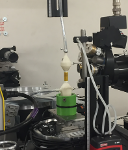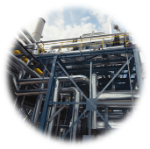____________________________________
Industrial Liaison Group:
Tel: +44 (0) 1235 778797
E-mail: industry@diamond.ac.uk
 There is a high demand to find long-term solutions to environmental problems we are currently facing, such as pollution and climate change. In order to overcome these issues, it is crucial to use advanced analytical techniques to study various materials in the areas of microbiology, geology, and geochemistry.
There is a high demand to find long-term solutions to environmental problems we are currently facing, such as pollution and climate change. In order to overcome these issues, it is crucial to use advanced analytical techniques to study various materials in the areas of microbiology, geology, and geochemistry.
Diamond’s facilities are uniquely placed for complex, advanced studies, providing an essential understanding of the problems and potential solutions related to environmental research.
Below are some examples of these environmental studies.

Particulate matter (PM) pollution remains a major public health concern. The installation of particulate filters on the exhaust of road vehicles with combustion engines has been critical in capturing PM before they pollute the environment.
However, the deposits cause the permeability of the filter to change continuously, and over time, without remediation, it can lead to excessive back-pressure from the exhaust, lowering the fuel efficiency of the engine and increasing greenhouse emissions.
Read more...
On 4th August 2014, the Mount Polley mine tailings dam failed, resulting in 25 million m3 of material discharged into the surrounding area, the second-largest failure by volume on record.
Mine tailings dam failures of this kind can rapidly add large volumes of vanadium (V)-bearing solid and liquid waste to the fluvial environment, with both short and long-term effects on the local ecosystems.

Poor air quality and reduced greenhouse gas emissions are at the forefront of public discussion, as well as being high on the agenda of worldwide policy makers. Many industries are embracing rapid changes in response, as is especially visible in the automotive sector, with the introduction of technologies such as gasoline particulate filters (GPFs). GPFs are positioned in a vehicle’s exhaust system and filter fine particulate matter (PM) produced by the engine. Recent legislation in places such as China, India and Europe will drive the adoption of GPFs on the majority of new gasoline, and hybrid electric, vehicles.
Whilst GPFs benefit public health and the environment by filtering out PM, they can also become gradually blocked by collected material. Captured carbonaceous particles (e.g. soot) can routinely oxidize away; however, inorganic PM (e.g. ash) typically remains in the filter for life, slowly blocking it and potentially reducing the fuel economy and power of the vehicle. Inorganic PM is predominantly derived from engine oil additive chemistry, which plays an important role in improving fuel economy, performance, and engine lifetime.
Read more...
In March 2011 a major earthquake hit Japan’s East coast. Although the six nuclear reactors at the Fukushima Daiichi Nuclear Power Plant (FDNPP) were robust enough to survive the seismic effects, the subsequent 15 metre tsunami had devastating effects, causing a power failure and loss of core cooling. Rising heat within the reactor cores caused the fuel rods to overheat and partially melt down, and radioactive material was released into the surrounding area.
Read more...
Over recent years we have seen a global move towards renewable energy not only to support increased demand for energy but also to reduce the production of carbon dioxide, a common pollutant from burning fossil fuels. Engineers and scientists are continually looking at ways to store this energy during periods of low user consumption (day-time) and to maximise its usage during periods of high demand (evening-time).
Read more....jpg)
In the chemical industry and industrial research, catalysis plays a vital role. Catalysts are in constant development to fulfil economic, political and environmental demands. Gaining valuable new information about the atomicnanoscale chemical structure, coupled with information about the micro-distribution of such species, has applications across a wide range of disciplines such as materials, biomedical, environmental, and geophysical sciences.
Read more....jpg)
In today’s battle against climate change, replacement of conventional cars with battery electric vehicles (BEV) offers an opportunity to significantly reduce future carbon dioxide emissions. Currently, BEVs employ lithium-ion batteries which are expensive to produce and have significant drawbacks; their safety and limited transport being the main issues. Significant interest is therefore being shown in replacing these lithium-ion batteries with a lithium-sulfur battery (LiS or Li2S/Si), which operates using a cheap and abundant raw material with about a two-fold higher specific energy compared to lithium-ion batteries.
Read more...
Management and disposal of higher activity radioactive wastes is a significant issue across the developed world as many countries with a history of nuclear power generation and military activities seek long term solutions for these materials. The most common disposal choice is containment within a deep geological disposal facility (GDF). To remain effective over the long term, the design of a GDF must limit the mobility and migration of radionuclides.
Read more...
”Corrosion resistant” metals are used in challenging environments and where safety is critical, such as in pipelines, aircraft and nuclear waste storage vessels. But it is precisely these materials that are vulnerable to a form of corrosion known as pitting. Understanding of the mechanisms by which these pits form and propagate may allow engineers to build more accurate models of corrosion to predict the lifetime of components and plan when they need inspecting or replacing.
Read more...
Catalytic production of methanol is an industrially important process and this high-energy density liquid is widely used in the manufacture of plastics and synthetic fibres, and in fuel cells. Currently, methanol is synthesized on a large scale using natural gas from an energy-inefficient process, which requires an endothermic, and therefore thermally intensive, step to completely break down the methane to CO/H2 before methanol can be formed. Scientists from the University of Oxford were keen to explore an alternative non-syn-gas route for methanol production utilising ethylene glycol (EG) which can be sourced from biomass.
Read more...
Using current technologies, it is possible to store and transport hydrogen as a liquid at very low temperatures, or a gas under very high pressure, but both of these have serious implications for weight, cost and safety. Metal-organic frameworks (MOFs) are extended molecular structures constructed from metal cations linked by organic molecules. They have recently shown considerable promise in a wide range of applications, including hydrogen storage, catalysis and drug delivery.
Read more...
Removing environmental contaminants such as heavy metals from polluted water systems is a problem across the globe. New advanced materials are needed that can prevent pollution and “clean up” existing contaminated environments. Green rust (GR) compounds are a unique class of materials which form in natural environments and can be synthesised in the laboratory. The unique structure and chemistry of GR nanoparticles means that these phases can chemically transform (reduce) and immobilise many toxic metals such as chromium and uranium. This process can significantly reduce the bioavailability of the contaminants.
Read more...Diamond Light Source is the UK's national synchrotron science facility, located at the Harwell Science and Innovation Campus in Oxfordshire.
Copyright © 2022 Diamond Light Source
Diamond Light Source Ltd
Diamond House
Harwell Science & Innovation Campus
Didcot
Oxfordshire
OX11 0DE
Diamond Light Source® and the Diamond logo are registered trademarks of Diamond Light Source Ltd
Registered in England and Wales at Diamond House, Harwell Science and Innovation Campus, Didcot, Oxfordshire, OX11 0DE, United Kingdom. Company number: 4375679. VAT number: 287 461 957. Economic Operators Registration and Identification (EORI) number: GB287461957003.